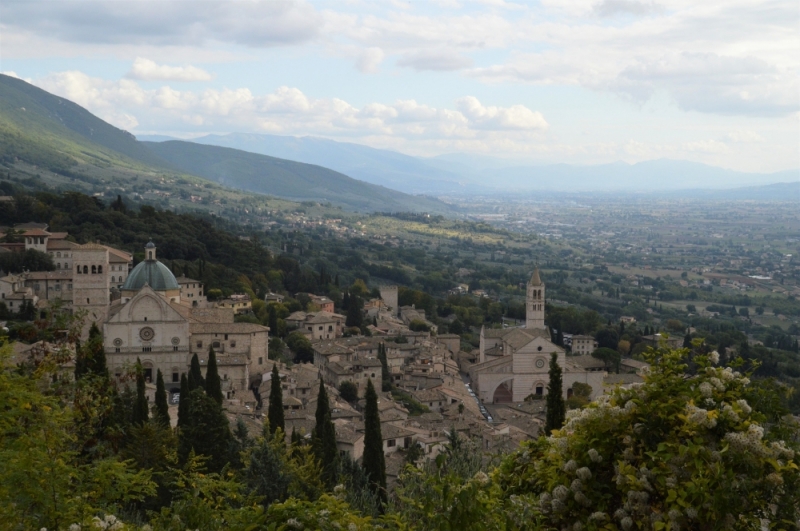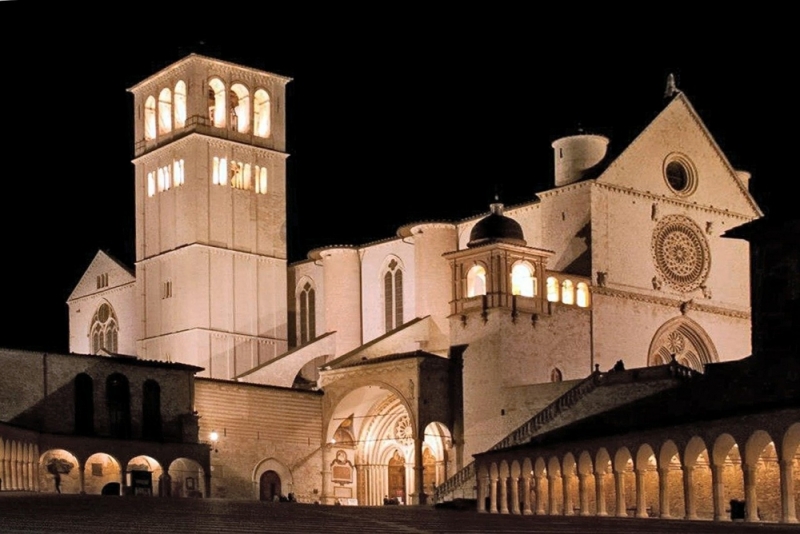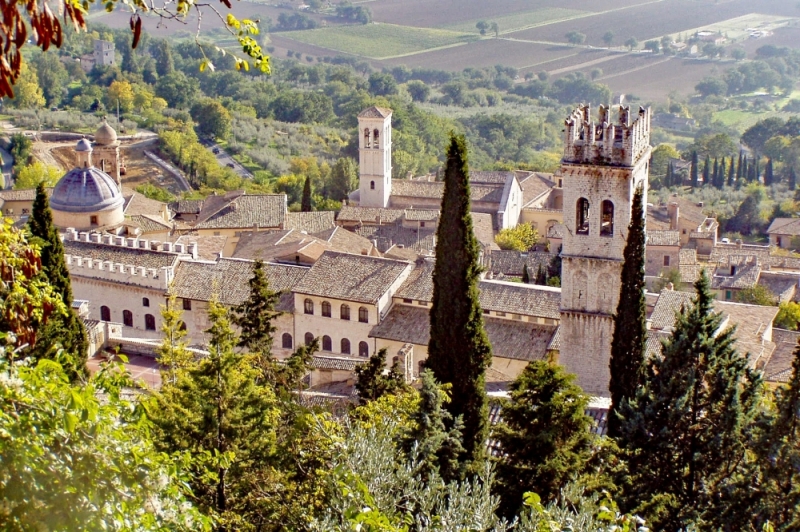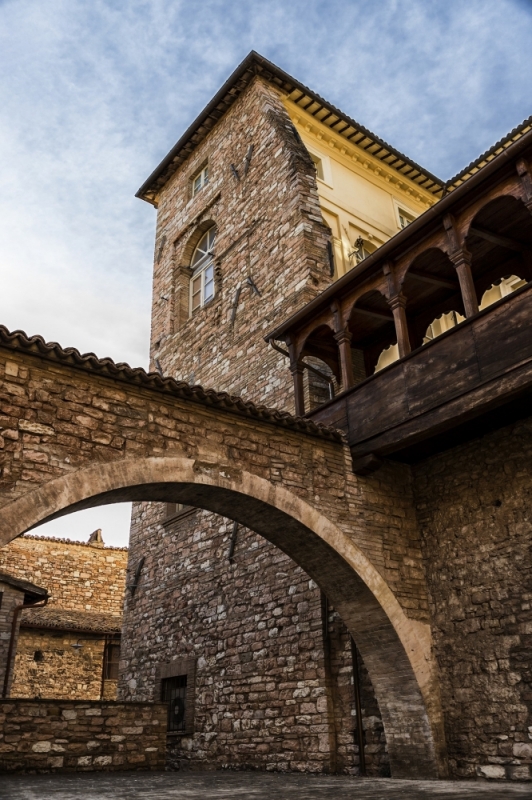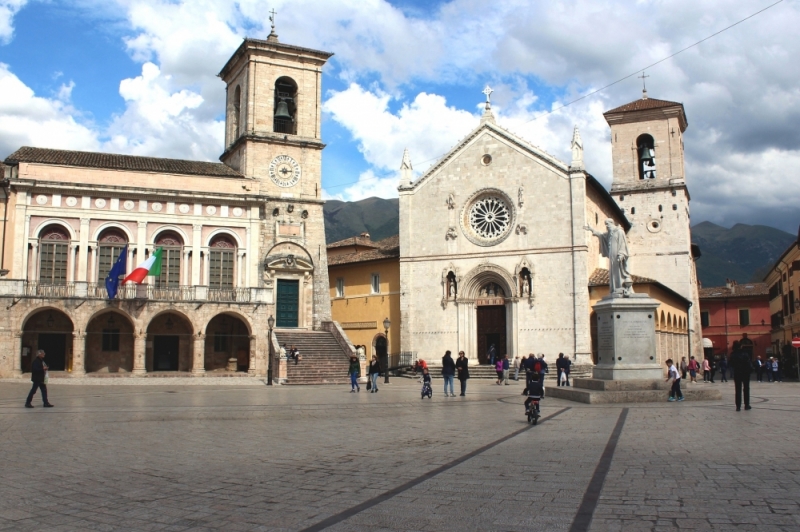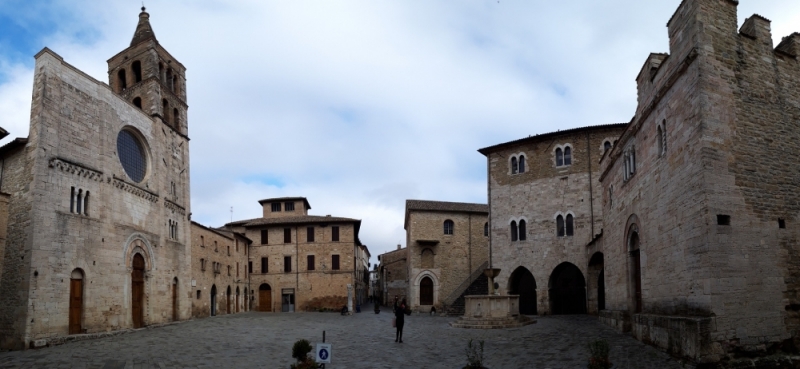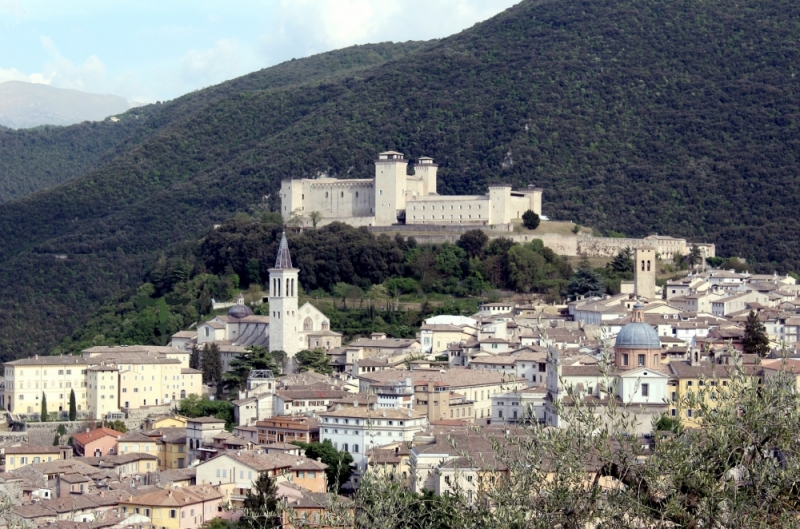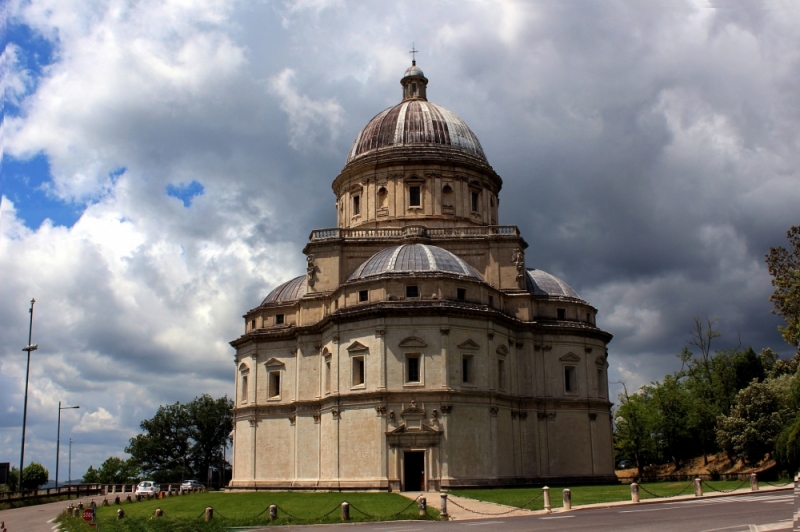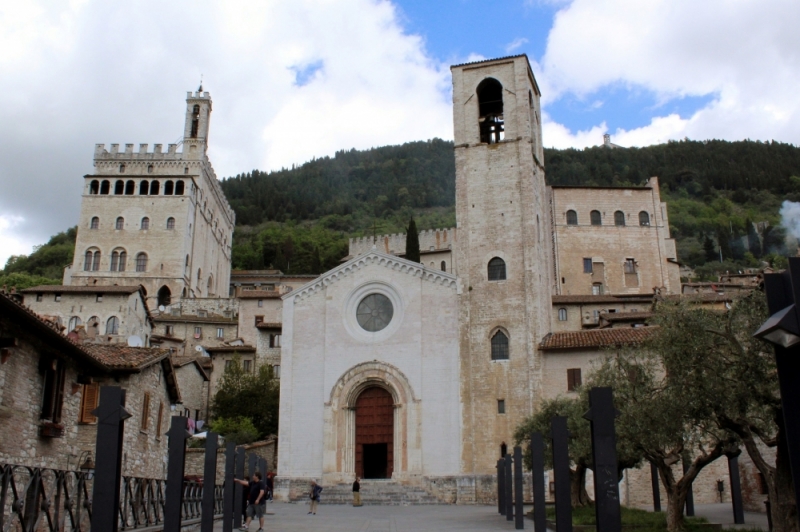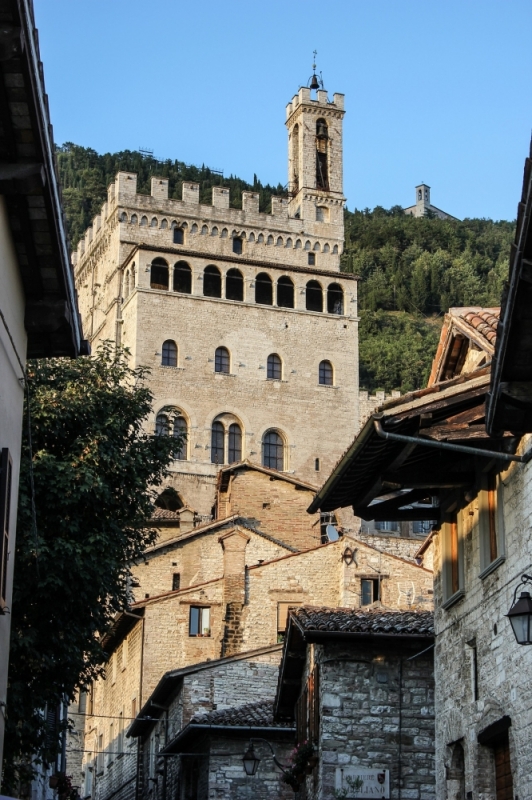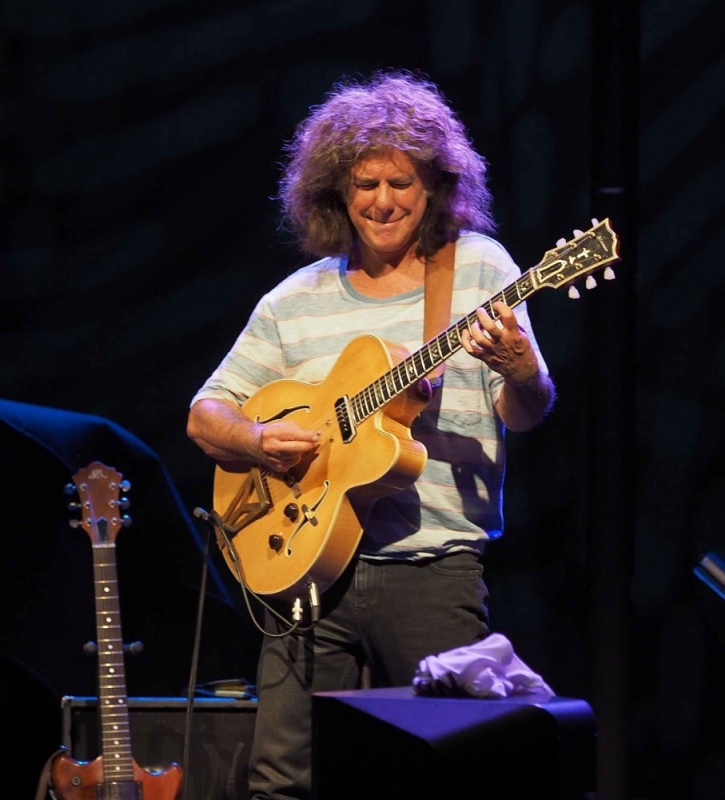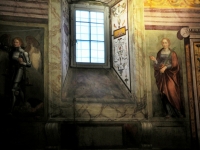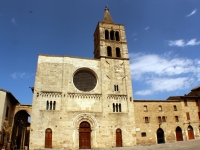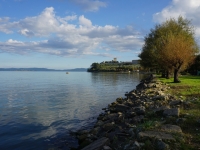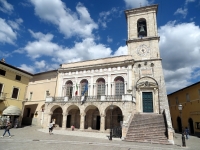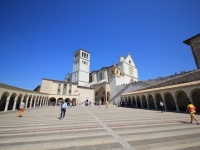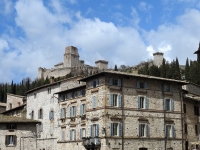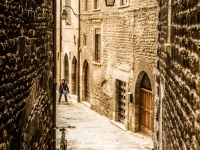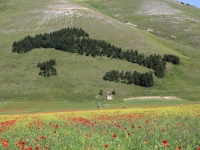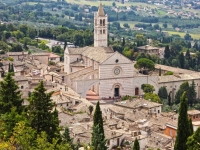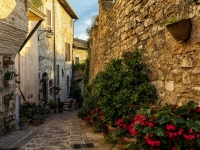Umbria and its pearls
In Umbria, there are numerous medieval villages, among the most picturesque in our country. Umbria is a region with a long history, with a unique artistic and architectural identity. In a naturalistic atmosphere, you can explore this region, among cobbled alleys, flowered balconies, churches and basilicas of great value. This region, which originates in the heart of the country and extends across the middle Tiber basin, is characterized by hills, mountains and valleys surrounded by greenery. Umbria is also bordered by Lake Trasimeno, the largest lake in central Italy, and in this area there are still the remains of Etruscan settlements, particularly in the Castiglione del Lago area, characterized by a relaxing and from romantic glimpses. Near Terni, however, there is the wonderful Natural Park of the Marmore Falls, among the highest in Europe, which over time has fascinated numerous poets and artists. The waterfalls, which plunge into the Nera river, are flanked by lush vegetation and are the ideal destination for lovers of canoeing, kayaking and more.
The best-known villages in the region are: Ass i si, Spello, Norcia, Castiglione del Lago, Bevagna, Spoleto, Todi and Gubbio.
The best-known villages in the region are: Ass i si, Spello, Norcia, Castiglione del Lago, Bevagna, Spoleto, Todi and Gubbio.
Assisi
As Giosuè Carducci revealed, "Assisi is a great thing, a town, city and sanctuary". Assisi has both the appearance of a village and that of a city. The appearance of the village is due to its position, as it is perched on top of a hill overlooking the valley and the city because it has played an important role throughout history: in fact, San Francesco started from here to follow his aim (i.e. to change the church). Assisi is also a sanctuary, because thanks to the passage of San Francesco and Santa Chiara, there are numerous sacred places, which attract faithful from all over the world. In addition to the religious places where Giotto and Simone Martini have left their mark, in Assisi there are a fortress, a Pinacoteca Civica, a Tempio della Minerva and a suggestive Piazza del Comune. The Basilica of San Francesco was built in 1230 following the sanctification of San Francesco. This Basilica is made up of two superimposed churches. The lower and upper Basilica, where there is a crypt with the tomb of the Saint. The two churches represent the testimony of Italian history, worked by Cimabue, Giotto, the Lorenzetti and Simone Martini. Another church linked to the saint, resides 4 km from the center of Assisi, and is the Basilica of Santa Maria degli Angeli in Porziuncola, built in order to protect some suggestive places that characterized the life of the saint.
The Porziuncola is known for having been the place where St. Francis composed the Canticle of the Creatures and where he had the vision in which Jesus conferred the indulgence on him. A suggestive place in the Porziuncola is the Rose Garden where, according to the story, the plants in contact with the saint's body lose their thorns. The Basilica of Santa Chiara is especially important because it represents the relationship that Santa Chiara had with the Saint. In fact, Santa Chiara escaped from her wealthy family, at the age of 18, to join Francesco and the first friars in the church of Santa Maria degli Angeli, already known then as Porziuncola. Later he moved to the Church of San Domenico , where he founded the order of the Poor Clares. The Temple of Minerva is so suggestive that Goethe was also amazed when he arrived in Assisi in 1786. The facade is perfectly preserved, with the six columns resting on the staircase, surmounted by a Corinthian-style capital. The main square of the city is Piazza del Comune , a square built where once there was a Roman forum . In this square, the main buildings overlook, such as: Palazzo del Capitano del Popolo and Palazzo dei Priori (now the seat of the town hall of Assisi). Although we have told you about the Basilica of San Francesco, as the sacred place par excellence, the main religious place in the city is the Cathedral of San Rufino . It is the oldest church in Assisi and is believed to have stood where there was once a temple dedicated to the Bona Mater. It was built in the twelfth century in honor of San Rufino, bishop and martyr of the third century. The Duomo is a symbol of the city's spirituality, as it was in this church that San Francesco and Santa Chiara were baptized. The facade is one of the most beautiful examples of Umbrian Gothic.
The palace that stands out for its majesty is Palazzo Vallemani, which is located a few minutes from Piazza del Comune. On the main floor, completely frescoed by Umbrian and Tuscan painters of the 1600s, there is the Municipal Art Gallery, with numerous frescoes dating back to the Middle Ages and the Renaissance. Among the most important works, there are a Maestà attributed to Giotto and some paintings by Perugino, while in the rooms on the first floor there is the Museum of Memory , Assisi 1943-1944, where the history of the 300 Jews saved from the Nazi extermination is revealed. Above the city, there is the Rocca Maggiore of Assisi, whose first construction, dating back to 1183, was commissioned by Federico Barbarossa. During a popular uprising it was destroyed, then rebuilt by the Cardinal d'Albornoz in 1365 and subsequently modified by numerous artists. In Assisi there is also a well-rooted culinary tradition. You can enjoy cutting boards enriched with Umbricelli, stringozzi, honey, bruschetta, flavored with local oil and the renowned truffle. As mentioned above, among the typical dishes we find stringozzi and umbrichelli, usually accompanied by sauces based on pork, hare or deer, an exquisite meat and pecorino. Furthermore, 5 DOC are produced in this area: red, rosé, new, white and Grachetto.
Spello
Spello is one of the most beautiful villages in Italy. It is a small village rich in artistic heritage, starting from the Roman era, up to the Renaissance. Spello is also known for its Infiorate , rich floral compositions created every year for Corpus Domini. You can start your tour, starting from the walls of Roman walls which still appear intact today, from which three doors open: Porta Urbica , Porta Consolare and Porta Venere . Not to be missed is the Church of Santa Maria Maggiore , where the famous Baglioni Chapel and the frescoes by Pinturicchio reside. Also worth a visit is the Roman house , dating back to the first century AD, which was brought to light thanks to the excavations carried out under the town hall. According to the inscription on the walls, the building seems to date back to Vespasia Polla (mother of Vespasiano) and it is still possible to admire the atrium with the original mosaic flooring. Continuing your tour, you will find the Church of S. Andrea , built in 1258 and today the seat of a community of Friars minor founded by Andrea Caccioli and the Church of San Lorenzo , with a very particular facade, which represents the fusion of the styles of several centuries. As previously revealed, the Corpus Domini Infiorata is an unmissable event held between May and June. The small cobbled streets are decorated with beautiful compositions of flowers, made by the locals or by various artists, making the city "the capital of flowers". If you want to know more about the history and art of this village, visit the Civic Museum and the Spello Art Gallery. The museum is housed in the Palazzo dei Canonici (16th century) and houses important works of art between the 13th and 18th centuries. Villa Costanzi, known as Villa Fidelia , was built on the ruins of a Roman sanctuary and has a terraced structure and was built at the behest of the Urbani family in the sixteenth century. It is home to cultural events and concerts and has a wonderful park full of ancient trees and an eighteenth-century palace. The history and tradition of the place are also contained in its culinary tradition. Typical dishes to try include Colfiorito red potato gnocchi with goose ragout, rapunzoli salad (radishes) and numerous legumes. Don't miss the risina (a variety of bean), the Spello chickpeas and the cicerchia.
Norcia
Norcia is a municipality in the province of Perugia, in the heart of the Umbria-Marche Apennines. Norcia is a town whose first settlements date back to the Neolithic period and was also conquered by the Romans in the third century BC. C., in fact, it is precisely to the Romans that Norcia owes its name, deriving from the Roman Goddess of Fortune, Northia. Given its position in the center of the Apennines, Norcia has been and is often the scene of disastrous earthquakes that have repeatedly razed it to the ground. The last major earthquake that caused serious damage to the town occurred on the night of October 26, 2016. With this earthquake a large part of the Basilica of San Benedetto , dating back to the thirteenth century, collapsed. Precisely because of the earthquakes, the priceless artistic heritage of Norcia has been lost over time, destroyed by the catastrophic events that have occurred throughout Central Italy. In fact, churches such as the Cathedral of Santa Maria Argentea or the Palazzo Comunale , have suffered extensive damage during the 2016 earthquake and are currently unusable. However, Norcia is still a beautiful village where you can visit many historic buildings, such as the Castellina , the fortified palace where the pontifical governor once resided. Today, the Castellina is a museum that houses temporary exhibitions. Norcia is also very famous for its gastronomy, in fact derive from the name of the town's famous pork butchers, ie butchers of central Italy, where it sells only pork, in the form of hams, sausages and pork. Prosciutto di Norcia is a PGI product and is famous for being covered with pink peppercorns. Also worth trying is the Corallina di Norcia , a very special salami.
Castelluccio di Norcia
Located within the Monti Sibillini National Park, there is the village of Castelluccio di Norcia, which is part of the hamlet of the Municipality of Norcia and is a village inhabited by just 150 people, also famous internationally for its truffle. The village is small and it is possible to visit it on foot. In the heart of the village, not to be missed are the Church of Santa Maria Assunt dating back to the sixteenth century, the remains of the sixteenth-century fortification and the Church of the Blessed Sacrament . Walking through its narrow streets, you can breathe the characteristic atmosphere of this village, getting lost in the beauty of the nature of the plateau below. Exploring its cobbled streets, the whitewashed writings on the walls will capture your attention, revealing a historical popular tradition, according to which the villagers wrote funny phrases in their dialect. Before leaving the village, stop in some small shop and buy the lentils of Castelluccio di Norcia. For lovers of trekking and excursions, there is Mount Carrier , one of the highest in the Apennines, where it is possible to visit Lake Pilate and the Sibilla Cave , considered according to legend the gateway to the underground kingdom of the Sibyl Queen, inhabited (always according to legend) by a magical creature. If you visit the village in the winter, you can enjoy the snow and winter sports, while in the summer you can lose yourself in the scents and colors of the Flowering plain of Castelluccio di Norcia. You can also try hang gliding or paragliding, or horseback riding enjoying the nature and colors of the place. If you are passionate about magic, the place also offers numerous itineraries concerning the legends and myths that tell of elves, fairies and witches who inhabit the place.
Castiglione del Lago
Castiglione del Lago is a village that stands on a promontory located on the western shore of Lake Trasimeno. This village owes its name to the family coat of arms that once dominated the place: the name in fact derives from the Latin Castellum Leonis, popularized in Castellioni. The ancient village, still surrounded by walls with three access doors, has still maintained its structure as a Roman city; remodeled over the centuries, it is possible to admire it today thanks to the Renaissance aspect that the Signori Della Corgna gave to the place. This village, thanks to its position, will offer you spectacular landscapes. Exploring the alleys, you will be able to admire the Palazzo Ducale della Corgna , an ancient residence of the lords of the village that has hosted numerous thick characters (such as Leonardo da Vinci and Niccolò Machiavelli) and its rooms are enriched with beautiful frescoes by artists such as Pomarancio and Savini. The Church of San Domenico di Guzman is certainly the most important church in the village, with a coffered ceiling and the tombs of the city's best-known citizens. Not to be missed is the Rocca del Leone , where you can walk on the ramparts and relive the history of the place. In the village there are also interesting events, such as the Tulip Festival , with the parades of the floats decorated with flowers, costumes and typical decorations.
Bevagna
Bevagna is a well-preserved village between the Roman and medieval walls, which maintains the urban layout dating back to the XII-XIII century. An important testimony of the Roman era are the remains of a temple , which over the centuries has first become the Church of the Madonna della Neve and, today is a thermal building where a floor mosaic dating back to the second century AD is visible. it was developed on the layout of the Roman city: in Piazza Silvestro stands the Palazzo dei Consoli (probably built by Maestro Prode in 1270), which houses the Francesco Torti Theater and three religious buildings, such as the church of San Michele , the church of San Domenico and the church of San Silvestro Giacomo . After Piazza Silvestri, along Via Santa Margherita, you will arrive in front of the church and Monastery of Santa Margherita , renovated in the 17th century. Going up to the highest point of the city, near Piazza Garibaldi , it is possible to admire the Church and the Convent of San Francesco , built at the end of the thirteenth century. The facade has a nave and an elegant portal and inside you can admire the paintings of Dono Doni and Ascensidonio Spacca. In the last decade of June, do not miss the Mercato delle Gaite , where characters in typical costumes will re-propose the ancient crafts of the past. As a local specialty there are the snails, the gnocchi with Sagrantino and the gnocchi filled with meat, the croutons with livers and spleen and the tozzetti with vinsanto.
Spoleto
Spoleto is considered among the most beautiful villages in Umbria, it has the dimensions of a city and a history ranging from prehistory to the Renaissance. Spoleto, the ancient capital of the Lombard duchies, will leave you breathless thanks to the richness of its historical and artistic heritage. Herman Hesse, in a postcard addressed to his wife wrote about Spoleto: "Spoleto is the most beautiful discovery I have made in Italy [...], there is such a wealth of almost unknown beauties, of mountains, valleys, oak forests, convents, waterfalls! " You can start your tour starting from the Rocca Albornoziana , which excells over the city, which is divided into two distinct areas: the Cortile d'onore, where the National Museum of the Duchy and the Cortile delle Armi resides, with an outdoor theater. The Ponte delle Torri , symbol of the village, connects the Rocca and the Monteluco. It is 230 meters long and 82 meters high and was probably erected between the thirteenth and fourteenth centuries. Visiting the Roman Theater , you can relive the atmosphere when Spoleto was part of the Roman Empire, just as it was in the past, you can also admire Palazzo Mauri (home of the municipal library), the Church of Sant'Ansano and the Crypt of Sant'Isacco and the Arch of Drusus and Germanicus .
Crossing the arch, before arriving in Piazza del Mercato, you will be able to see the entrance to Palazzo Leti Sensi , which was once the mayor's palace while today it is used as a venue for exhibitions and events. In Piazza del Duomo, don't miss the Cathedral of Santa Maria Assunta, symbol of Romanesque architecture, where important frescoes by Pinturicchio and Filippo Lippi are kept. If you want to fully experience Spoleto, we recommend treating yourself to a Giro della Rocca: a panoramic tour from which you can admire the Spolento valley. If looking at all the greenery that surrounds you, you will want to take a dip in nature, we recommend a walk in the sacred forest of Monteluco , a forest made up mainly of holm oaks, which winds through numerous paths that will lead you to numerous areas of historical interest and naturalistic. After exploring the village, we recommend stopping in a typical restaurant and trying the famous black truffle, the protagonist of Spolento cuisine. Also worth trying is the Trevi celery, to be tried both raw and accompanied by Trevi oil. For dessert, try the cresonda, a dessert made with eggs, flour, chocolate, amaretti and mistral.
Todi
Famous for being " the most livable city in the world" , Todi is an elegant and characteristic medieval town, located on top of a hill, on the enchanting Tiber valley. Located a few kilometers from Perugia and Orvieto, the town is protected by three circles of walls (Etruscan, Roman and medieval), where numerous treasures are kept. The heart of city life is Piazza del Popolo , where some of the most important buildings in the historic center overlook. Here you can admire the complex of the Palazzo Comunale , formed by the Lapidary Museum, the Pinacoteca Civica and the Etruscan Roman Museum, Palazzo del Capitano and Palazzo dei Priori, which was finished in the 14th century. The Cathedral , built in the XII century on the remains of a temple dedicated to the god Apollo, is characterized by an access staircase and a Romanesque facade. From the top of the steps, you can also take photos and enjoy the spectacle of the square. Not far from the Duomo, there is the Church of San Fortunato , built in the thirteenth century for the patron saint of the city, where the tomb of Jacopone da Todi, a famous poet and humanist, is kept inside the crypt. Todi is also beautiful ... underground. In fact, below Piazza del Popolo , it is possible to visit the Cisterns built by the Romans, which once collected Roman water. If you want to experience the medieval atmosphere of the past, stroll
for the medieval villages of Ulpiano, Nuovo and Porta Fratta. Inside the cobbled alleys, you will find ancient artisan shops. Near Piazza Garibaldi, you can enjoy the view of the countryside below, or climb the bell tower of San Fortunato , from which you can also see Perugia. To enjoy some peace and relaxation, visit the Temple of Consolation, built in the 16th century thanks to Bramante's project. The building has a central plan structure, surmounted by a dome and, on the altar, there is an ancient image of the Madonna, which according to tradition was miraculous. In the surroundings of Todi, you can also visit the castles that once represented the defensive system of the area. After exploring this beautiful medieval village, enjoy its good food. On the tables there is certainly the pan caciato (a pan enriched with cheese nuts and raisins), as well as the palomba alla ghiotta, perhaps accompanied by a Grechetto di Todi DOC.
Gubbio
Thanks to the seven bronze Eugubine plates written in the Umbrian language, preserved in the local Palazzo dei Consoli Civic Museum , we can affirm that the origins of Gubbio date back to the height of the Umbrian civilization. Passing into Roman hands, then of the Goths (552), then of the Byzantines (592), then of the Longobards, (772), in the twelfth century Gubbio, with the spiritual guidance of Bishop Ubaldo, won a war against Perugia and other nearby cities. Thanks to its thriving manufacturing activity, majolica, it reached its peak in the 14th century, when the town took on the features of a medieval village full of monuments. From 1384 it became part of the Duchy of Urbino and with this it passed to the Church in 1631. Today Gubbio is among the oldest villages, but also best preserved in Umbria. Beautiful evidence of the past is the Roman theater located just outside the walls. The monumental basilica of Sant'Ubaldo , guardian of the remains of the patron saint. To see the urban complex of Palazzo dei Consoli (XIV century), symbol of the city and museum, the hanging square (Piazza Grande) and the Palazzo Pretorio , now the seat of the Town Hall. Also worth seeing is Palazzo Beni , Palazzo del Bargello with the famous fountain called "dei Matti", and Palazzo del Capitano del Popolo .
The Palazzo Ducale, dating back to the Renaissance, is a testimony to the rich period lived under the lordship of the Montefeltro family. The beautiful Cathedral (XII century), dedicated to Saints Mariano and Giacomo, Santa Maria Nuova, inside which is the Madonna del Belvedere by Ottaviano Nelli, the church of Sant'Agostino (XIII century) just outside the walls, San Pietro and the church of Sant'Andrea or Monastery of San Marziale. The church of San Domenico was built by the Dominicans who settled in the nearby convent at the beginning of the 14th century, on the smallest church of San Martino , which already existed in 1180. In the Middle Ages the market was held in the current Piazza Quaranta Martiri , which houses the church of San Francesco , erected at the Spadalonga warehouse, a family who welcomed and dressed San Francesco after leaving the paternal home. Opposite, you can admire the Loggia dei Tiratorie , always nearby, the church of San Giovanni, probably one of the oldest religious buildings in the city. Outside the walls, to see the Roman Mausoleum, the church of San Secondo, the church of Madonna del Prato and the church of Vittorina . If you want to relax, do not miss a visit to the Monte Cucco Naturalistic Park , with the suggestive Bottaccione Gorge. Do not leave the "city of the mad" without having taken a tour of the Ranghiasci Park, a green area that climbs along the old walls starting from one of the ancient city gates and which offers one of the best views of Gubbio. Not everyone knows that in Gubbio you can win the "madman's license". Like? Reach Largo Bargello where you will find a small fountain around which you will have to turn three times to earn your mad driver's license (and citizenship of the EU)! If you do not suffer from vertigo it is worth climbing the top of Monte Ingino (908 asl) with the cable car to admire the Basilica of Sant'Ubaldo which houses the remains of the saint and the famous candles. A visit to one of the ancient blacksmith shops that you will find around the village is compulsory, where incandescent materials are still handmade by beating them on the anvil.
Entertainment
For the sweet tooth you can book a visit to the historic Perugina, the Umbrian chocolate house, famous for its Baci, simply by going to the company website. And, speaking of chocolate, if you decide to go to Umbria in October, pay attention to the dates you choose so you can go to Perugia's Eurochocolate. The event is usually held between the second and third week of October, when Perugia becomes the capital of chocolate. For those who love good music, especially Jazz, don't miss the Umbria Jazz Festival , which usually takes place in July, in Perugia. Instead, you can organize yourself to visit Spoleto, during the Festival dei Due Mondi , a great cultural event that is usually held in December and sees the presence of numerous theatrical personalities, such as Eleonora Abbagnato and Roberto Bolle. Finally, for lovers of good food, there are many taverns where you can try the products of the Umbrian cuisine.
In Umbria, surrounded by greenery, you can devote yourself to hiking, biking and mountain biking, canyoning, rafting and water sports or, if you are more courageous, to extreme sports such as hang gliding, paragliding or hot air ballooning. At high altitude, you can admire hills, vineyards and medieval villages from above, enjoying nature and breathtaking landscapes. If you love horses, you can also take a ride among its rolling hills or simply relax in the shade of a tree and enjoy the beauty of this land. For those who decide to visit Umbria, turning by car, we advise you to "cross over" and pay a visit to the Marmore Falls , in the province of Terni. It is the highest waterfall in Europe, consisting of 3 jumps, a total height difference of 165 m. Here, if you are lucky, you will also have the opportunity to see many birds, such as the Kingfisher and the Nightingale.
Climate, curiosity and advice
Climate : the climate of Umbria has a continental character compared to the other central-southern regions. The presence of the Apennine mountains in Umbria affects the climate in this region. Summers are hot, with values that even exceed 30 ° C, while on the mountain belt, temperatures are mitigated by altitude, and storms also play an important role, slowing down the summer heat. In winter, to influence the climate, there are winds from the north or north-east that also bring snow to the mountains. Temperatures in the Apennine areas can reach peaks of -30 ° C.
Curiosity : according to a legend, a German friar brought the wedding ring of the Madonna to Perugia, after several adventures and spells. To date, it is said that in the Cathedral of San Lorenzo, in Piazza 4 novembre, there are the relics of the wedding ring of the Madonna and that, to open them, 14 keys are needed.
Tips : if you want to enjoy the atmosphere of this region, we recommend you to stay in historic residences, made of stone and surrounded by greenery.
Curiosity : according to a legend, a German friar brought the wedding ring of the Madonna to Perugia, after several adventures and spells. To date, it is said that in the Cathedral of San Lorenzo, in Piazza 4 novembre, there are the relics of the wedding ring of the Madonna and that, to open them, 14 keys are needed.
Tips : if you want to enjoy the atmosphere of this region, we recommend you to stay in historic residences, made of stone and surrounded by greenery.


